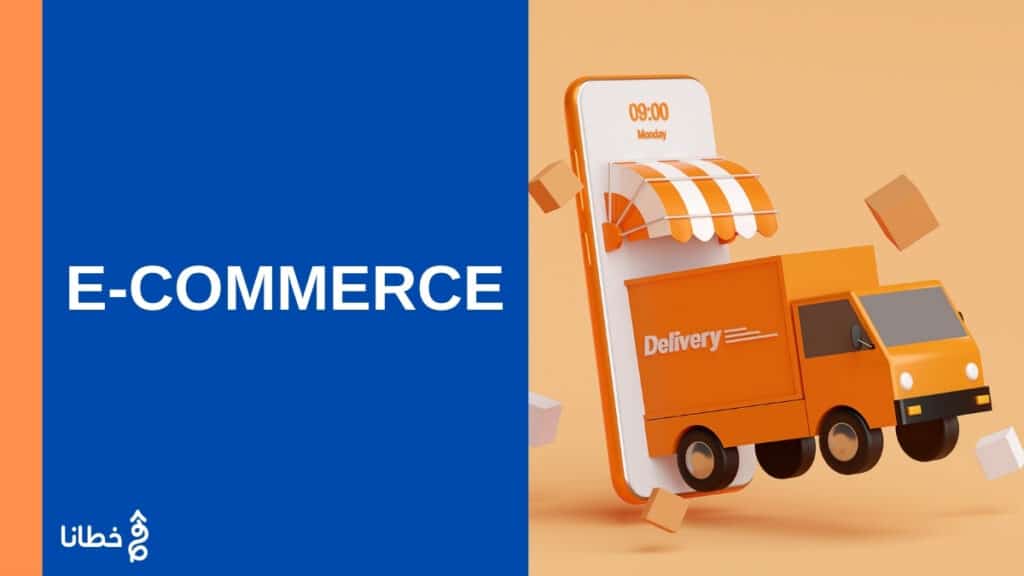جدول المحتويات
E-commerce has become an integral part of our daily lives. From buying clothes and electronic devices to booking tickets and hotels, all of this can be done with the click of a button through the Internet. E-commerce has not only made our lives easier, but it has also opened new doors for entrepreneurs and companies to reach new customers all over the world. In this article, we will review with you, dear reader, everything related to e-commerce, from its definition and types to its advantages and challenges, and how you can start your project in this field and achieve success.
The importance of e-commerce in the modern era:
Expanding Business: E-commerce helps businesses reach customers all over the world, not just in the local area.
- Save time and effort: Instead of going to stores and searching for products, you can buy everything from home with the click of a button.
- Cost saving: Companies do not need to pay rent for shops or salaries for a large number of employees, which reduces costs.
- Ease of access: Online stores are open 24 hours a day, meaning you can shop at any time that suits you.
- Improve customer experience: Customers can compare products and read people’s reviews and opinions before they buy.
- Data collection: Companies can collect data about customer behavior and needs, which helps them improve their services and products.
E-commerce has become an essential part of our daily lives, and it makes many things easier for us in buying and selling.
What is e-commerce?
E-commerce is simply the process of buying and selling products or services over the Internet. This means that instead of going to the store yourself, you can buy whatever you want through your computer or mobile phone. E-commerce includes everything from clothes and electronic devices to services such as booking airline tickets and hotels.
Types of e-commerce:
- Business-to-business (B2B) e-commerce: This type involves commercial transactions between two or more companies. An example of this is companies selling wholesale products to other companies such as suppliers and manufacturers.
- Business-to-Consumer (B2C) e-commerce: The most common type and involves selling products or services directly to the end consumer. Examples of this are sites like Amazon and Souq.com.
- Consumer-to-Consumer (C2C) e-commerce: In this type, consumers buy and sell from each other. Sites like OLX and eBay are excellent examples of this type.
- Consumer-to-Business (C2B) e-commerce: In this type, consumers offer products or services to businesses. An example of this is freelance sites like Upwork and Freelancer.
- Business-to-Government (B2G) e-commerce: This type includes commercial transactions between companies and government institutions. Companies provide products or services to the government through contracts and tenders.
- Consumer-to-government (C2G) e-commerce: In this type, consumers interact with the government electronically to pay bills, and taxes, or obtain government services.
Each of these types has its own advantages and challenges, and choosing the right type for your business will help you achieve success and growth in the online market.
The difference between e-commerce and e-marketing:
- E-commerce: Includes all the processes that take place to buy and sell products or services online. That means when you buy a mobile phone from a site like Amazon or sell any used product on OLX, this is considered e-commerce. Simply put, e-commerce is the process of buying and selling itself.
- E-marketing: Includes all the activities you do to promote your products or services online. That is, when you create an ad on Facebook or Google, send promotional emails, or even write articles on your blog to attract visitors, all of this is considered e-marketing. E-marketing is the tool that helps you get customers and make them buy your products or services.
In other words, e-commerce is the process of buying and selling, and e-marketing is what helps you bring customers and make them buy. The two are related to each other, but each one has its own role.
How do I start e-commerce from scratch?
Ok, let’s start step by step, dear, so that things are clear and easy for you:
- Define the product or service: The first thing you need to do is decide what product you will sell. It could be physical products like clothing or electronics, or services like graphic design or consulting.
- Research the market and competitors: You should know who sells the same product or service that you intend to provide, and look for what distinguishes them and what you can do better.
- Choose an e-commerce platform: There are many platforms such as Shopify, WooCommerce, and BigCommerce. Choose the one that suits your needs and budget.
- Create your online store: Design your website to be easy to use and attractive to visitors. Pay attention to details such as images, descriptions, and prices.
- Setting up payment and shipping methods: You should provide various payment methods such as credit cards and PayPal, and also arrange with shipping companies to deliver products to customers.
- Marketing your store: Use social media, paid advertising, and content marketing to attract visitors to your site.
- Customer Service: Provide excellent customer service to ensure customer satisfaction and loyalty.
Best e-commerce sites:
Souq.com: It was one of the largest e-commerce sites in the Arab world, but now it has become part of Amazon after it was acquired. It offers many products in various fields.
Jumia: A popular site in Egypt and North African countries. It offers a variety of products from clothing and electronics to furniture and even services.
Noon.com: A highly competitive site in the Arab market, operating in Saudi Arabia, the Emirates, and Egypt. It offers a variety of products with reasonable quality and prices and is famous for its fast services.
Namshi.com: A website specialized in fashion. It displays clothes, shoes, and accessories from international and local brands. It operates mainly in the Gulf.
AliExpress: Although it is a global site, it is very popular in the Arab world because of its cheap prices and variety of products, especially from China.
Wafi (Wafiapps.com): A site that mainly serves Bahrain and offers a variety of products from electronics to fashion.
Is e-commerce halal or haram?
This question is very important and occupies the minds of many people. E-commerce, like any other type of commerce, is judged by the type of products or services being traded and the method of dealing. If the products or services you sell are halal and do not violate Islamic law, and the financial transactions are conducted in a lawful manner (such as avoiding usury and fraud), then e-commerce is halal. But if the products or services contain something forbidden or the financial transactions involve usury or fraud, then this makes the trade forbidden. To be more certain, you can consult a trusted sheik or religious scholar to give you the fatwa appropriate for your particular situation.
How do I start e-commerce without capital?
There is no problem at all, you can start e-commerce even if you do not have capital. There is more than one way you can start:

1- Dropshipping: This is a method that does not require storing products. Simply, you display the products on your website and when anyone buys, the supplier ships the product directly to the customer. This way, you do not need to pay money in advance for the products.
2- Print on Demand: If you have beautiful and unique designs, you can use sites like Printify or Printful to print the designs on products such as T-shirts and mugs and sell them. The site takes care of printing and shipping, and you take a percentage of the profits.
3- Affiliate Marketing: Here you promote the products or services of other companies, and when someone buys through your link, you get a commission. You can start by creating a blog or YouTube channel and promote products that suit your audience.
4- Selling services (Freelancing): If you have skills such as graphic design, writing, or digital marketing, you can offer your services on sites such as Upwork or Fiverr and start earning money without needing capital.
5- Reselling used products: You can start by buying used products in good condition from sites like OLX or from local markets, and reselling them on platforms like eBay or Amazon.
All of these methods do not require a large capital, but you need to put in effort and marketing so that you can bring in customers.
E-commerce terms:
- E-commerce: Simply put, all buying and selling that takes place on the Internet.
- Dropshipping: A way to sell products without having to store them. You display the products on your website, and when someone buys, the supplier ships the product directly to the customer.
- Affiliate Marketing: You promote the products or services of other companies, and when someone buys through your link, you will receive a commission.
- Shopping Cart: This is the place where the customer collects the products he wants to buy on the site before completing the purchase process.
- Cash on Delivery: The customer pays for the product when it arrives, not at the time of purchase on the website.
- Cost Per Click (CPC): The cost each time someone clicks on your ad.
- Conversion Rate: The percentage of visitors who convert into actual customers and complete a purchase.
- Search Engine Optimization (SEO): Preparing your website to appear in the first search results on Google and other search engines.
- Social Media Marketing (SMM): Using platforms like Facebook, Instagram, and Twitter to promote products and services.
- Landing Page: The page that the visitor reaches after clicking on the advertisement link, and it contains details of the product or service.
Advantages and disadvantages of e-commerce:
Advantages of e-commerce:
- Global Reach: You can sell your products to anyone anywhere in the world, not just in your area.
- Lower costs: You don’t need to pay store rent or high operating expenses like traditional stores.
- Comfort and flexibility: You can manage your business from anywhere and at any time, you are not tied to a specific place.
- Digital Marketing: You can benefit from digital marketing tools such as ads on Google and Facebook to reach a larger number of customers.
- Data Analysis: You can track and analyze customer behavior on your site and know what will sell quickly. And what needs improvement.
- Rapid expansion: If your business is successful, you can expand quickly and easily add new products.
Disadvantages of e-commerce:
- High Competition: The online market has a large number of competitors, which makes it difficult to stand out.
- Trust and Security: Some customers are hesitant to buy online due to security and fraud concerns.
- Shipping and delivery issues: You may encounter problems delivering products to customers on time or in good condition.
- Technical costs: You may need to invest in developing and maintaining your website.
- Handling Returns: Managing returns and product exchanges can be a complex and costly process.
- Continuous update: You need to keep up with changes in the market and technology to stay competitive.
E-commerce Success Strategies:
- Continuous expansion and development: Always think of new ways to develop your business and add new products. The market is changing rapidly, and you must be ready to adapt to changes in the world of e-commerce.
- Choosing the right product: You should choose a product that is in demand, but at the same time the market is not saturated with it. Do good research to see what people like? And what people are looking for in the world of e-commerce.
- Improve User Experience (UX): Make your site easy to use and attractive. Visitors should find what they are looking for quickly and without complications.
- Search Engine Optimization (SEO): Take care of optimizing your site so that it appears in the first search results on Google. Use appropriate keywords and write valuable content.
- Social Media Marketing: Use platforms like Facebook, Instagram, and Twitter to promote your products. Run paid ads and engage with your audience.
- Content Marketing: Write articles and blogs about the products you sell. Provide valuable tips and information to attract visitors to your site.
- Excellent customer service: Take care to respond to customer inquiries quickly and solve their problems. Good customer service makes customers come back to buy from you again and again.
- Analyze and track: Use tools like Google Analytics to track your site’s performance and see what needs improvement. Analyze the data and make decisions based on the numbers.
- Offers and discounts: Make offers and discounts from time to time to attract customers and encourage them to buy.
- Collaborating with influencers: Collaborate with influencers in your niche to promote your products. This helps increase brand awareness and attract new customers.
Out of the box ideas in e-commerce:
Innovative ideas are what make your project stand out from the competition. They can help you in e-commerce:
- Customization: Offer products that are personalized to your customers, such as custom T-shirts or name-engraved jewelry. People love things that express their personality.
- Subscription Boxes: Create monthly subscription boxes with a variety of products. For example, a monthly box of cosmetics or office supplies. Customers love monthly surprises.
- Social Commerce: Use social media platforms not only for marketing but also for direct selling. For example, use Instagram Shop or Facebook Marketplace.
- Augmented Reality (AR): Use AR technologies to help customers try on products before they buy them, such as sunglasses or furniture at home.
- Digital Products: Sell digital products such as e-books, courses, or templates. Digital products do not require shipping and have a high-profit margin.
- Collaborate with local artists: Partner with local artists to create unique and exclusive products. This gives your products a distinctive character and attracts art lovers.
- Sustainable Commerce: Offer environmentally friendly and sustainable products. People are becoming more interested in products that protect the environment.
- Virtual Experiences: Create virtual experiences like workshops or virtual product tours. This makes customers feel more connected to the brand.
- Artificial Intelligence (AI): Use AI technologies to provide personalized recommendations to customers based on their behavior and preferences.
- Niche Products: Focus on a specific niche market with unique products. For example, products for video game enthusiasts or pet supplies.
Ultimately, e-commerce is not just a way to sell products and services, but also an opportunity to create unique and innovative experiences for customers. With the rapid development of technology, e-commerce has become an integral part of our daily lives, opening new doors for entrepreneurs and consumers alike. Whether you are starting your project from scratch or expanding your current business, e-commerce provides you with the tools and opportunities to achieve success and growth. Always remember that the secret to success is innovation, adapting to change, and providing real value to customers. Good luck on your journey in the world of e-commerce.
Discover more articles:
Email Marketing with 3 Steps to Email Marketing Campaigns
Is social media marketing an effective way to market services or not? 9 tips
Snapchat Marketing Your Guide to Learn It Easily and Follow 3 Important Tips
Your comprehensive guide to creating successful blogs in 5 steps
Questions about the article E-commerce – A comprehensive guide to making money online 2025
What is e-commerce and how to explain it?
Electronic commerce (e-commerce) is the buying and selling of goods and services, or the transfer of money or data, over an electronic network, primarily the Internet.
What are the types of e-commerce?
Business to Business (B2B) Business to Consumer (B2C) Consumer to Consumer (C2C) Consumer to Business (C2B)
What is the function of e-commerce?
E-commerce jobs are jobs that complete the tasks necessary to buy and sell products and services online. As more brands and businesses use the internet to market, sell, and promote their offerings, the demand for these types of jobs is likely to continue to grow.
Is Amazon an e-commerce platform?
Amazon.com visits have grown from 615 million annual visitors in 2008 to more than 2 billion monthly visitors in 2022. The e-commerce platform is the 12th most visited website in the world.
We respect and value your time... Half an hour to grow your project





